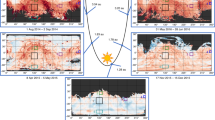Abstract
The modern understanding of comets dates from the publication in the early 1950s of three crucial ideas: that of a comet cloud around the Sun, that of the dirty-ice comet nucleus, and that of the “solar wind” to explain the comet tail. Starting from those three ideas, the observations of the past 25 years have led to the explanation of all the mysterious and sometimes spectacular phenomena associated with comets.
This is a preview of subscription content, access via your institution
Access options
Subscribe to this journal
Receive 51 print issues and online access
$199.00 per year
only $3.90 per issue
Buy this article
- Purchase on Springer Link
- Instant access to full article PDF
Prices may be subject to local taxes which are calculated during checkout
Similar content being viewed by others
References
Ho Peng Yoke, Vistas in Astronomy, 5, 127 (1962).
Marsden, B. J., Catalogue of Cometary Orbits (Smithsonian Astrophysical Observatory, Washington, 1975).
Berry, A., A Short History of Astronomy, 193 (Scribners, New York, 1910).
Swings, P., Lick Observatory Bulletin No. 19 131 (1941).
Wurm, K., Mitt. Hamburg. Sternw., Bergedorf., 8, 57 (1943).
Bessel, F. W., Astr. Nachr., 13, 345 (1836).
Dubiago, A. D., Russ. Astron. J., 25, 361 (1948).
Oort, J., Bull. Astr. Insts. Netherlds., 11, 91 (1950).
Öpik, E. J., Proc. Am. Acad. Arts Sci., 67, 169 (1932).
Whipple, F. L., Astrophys. J., 111, 375 (1950); ibid., 113, 464 (1951); ibid., 121, 750 (1955).
Biermann, L., Z. Astrophys., 29, 274 (1951).
Whipple, F. L., Proc. Am. Acad. Arts Sci., 83, 84 (1940).
Whipple, F. L., and Gossner, J. L., Astrophys. J., 109, 545 (1949).
Him, G. A., Constitution de l'espace Céleste, 254 (Gauthier-Villars, Paris, 1889).
Swings, P., Ann. Astrophys., 11, 124 (1948).
Delsemme, A. H., and Swings, P., Ann. Astrophys., 15, 1 (1952).
Hamid, S. E., and Whipple, F. L., Astrophys. J., 58, 819 (1953).
Marsden, B. J., Sekanina, Z., and Yeomans, D. K., Astr. J., 78, 211 (1973).
Biermann, L., and Trefftz, E., Z. Astrophys., 49, 111 (1960).
Code, A. D., Houck, T. E., and Lillie, C. F., IAU Circ., No. 2201 (1970).
Bertaux, J. L., and Blamont, J. C., C. r. hebd. Séanc Acad. Sci., Paris, B 270, 1581 (1970).
Huebner, W. F., Snyder, L. E., and Buhl, D., Icarus, 23, 580 (1974).
Ulich, B. L., and Conklin, E. K., Nature, 248, 121 (1974).
Sekanina, Z., IAU Circ., No. 2943 (1976).
Author information
Authors and Affiliations
Rights and permissions
About this article
Cite this article
Whipple, F. Background of modern comet theory. Nature 263, 15–19 (1976). https://doi.org/10.1038/263015a0
Issue Date:
DOI: https://doi.org/10.1038/263015a0
This article is cited by
-
The comet Halley dust and gas environment
Space Science Reviews (1986)
-
Radiation chemistry of overirradiated aqueous solutions of hydrogen cyanide and ammonium cyanide
Journal of Molecular Evolution (1985)
-
Terrestrial catastrophe caused by cometary impact at the end of Cretaceous
Nature (1980)
-
Rotation period of comet Donati
Nature (1978)
Comments
By submitting a comment you agree to abide by our Terms and Community Guidelines. If you find something abusive or that does not comply with our terms or guidelines please flag it as inappropriate.



